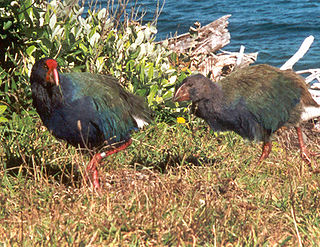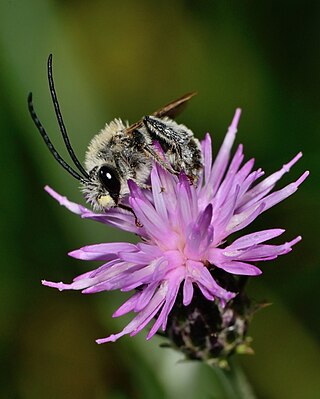
Bees are winged insects closely related to wasps and ants, known for their roles in pollination and, in the case of the best-known bee species, the western honey bee, for producing honey. Bees are a monophyletic lineage within the superfamily Apoidea. They are currently considered a clade, called Anthophila. There are over 20,000 known species of bees in seven recognized biological families. Some species – including honey bees, bumblebees, and stingless bees – live socially in colonies while most species (>90%) – including mason bees, carpenter bees, leafcutter bees, and sweat bees – are solitary.

Genus is a taxonomic rank above species and below family as used in the biological classification of living and fossil organisms as well as viruses. In binomial nomenclature, the genus name forms the first part of the binomial species name for each species within the genus.

The Clusiaceae or GuttiferaeJuss. (1789) are a family of plants including 13 genera and ca 750 species. Several former members of Clusiacae are now placed in Calophyllaceae and Hypericaceae. They are mostly trees and shrubs, with milky sap and fruits or capsules for seeds. The family is primarily tropical. More so than many plant families, it shows large variation in plant morphology. According to the APG III, this family belongs to the order Malpighiales.
In biology, a monotypic taxon is a taxonomic group (taxon) that contains only one immediately subordinate taxon. A monotypic species is one that does not include subspecies or smaller, infraspecific taxa. In the case of genera, the term "unispecific" or "monospecific" is sometimes preferred. In botanical nomenclature, a monotypic genus is a genus in the special case where a genus and a single species are simultaneously described. In contrast, an oligotypic taxon contains more than one but only a very few subordinate taxa.

Halictidae is the second-largest family of bees with nearly 4,500 species. They are commonly called sweat bees, as they are often attracted to perspiration. Halictid species are an extremely diverse group that can vary greatly in appearance. These bees occur all over the world and are found on every continent except Antarctica. Usually dark-colored and often metallic, halictids are found in various sizes, colors and patterns. Several species are all or partly green and a few are red, purple, or blue. A number of them have yellow markings, especially the males, which commonly have yellow faces, a pattern widespread among the various families of bees. The family is one of many with short tongues and is best distinguished by the arcuate basal vein found on the wing. Females in this family tend to be larger than the males. They are the group for which the term 'eusocial' was first coined by entomologist, Suzanne Batra.

In biology, a type is a particular specimen of an organism to which the scientific name of that organism is formally associated. In other words, a type is an example that serves to anchor or centralizes the defining features of that particular taxon. In older usage, a type was a taxon rather than a specimen.

In paleontology, a Lazarus taxon is a taxon that disappears for one or more periods from the fossil record, only to appear again later. Likewise in conservation biology and ecology, it can refer to species or populations that were thought to be extinct, and are rediscovered. The term Lazarus taxon was coined by Karl W. Flessa and David Jablonski in 1983 and was then expanded by Jablonski in 1986. Paul Wignall and Michael Benton defined Lazarus taxa as, "At times of biotic crisis many taxa go extinct, but others only temporarily disappeared from the fossil record, often for intervals measured in millions of years, before reappearing unchanged". Earlier work also supports the concept though without using the name Lazarus taxon, like work by Christopher R. C. Paul.

A botanical name is a formal scientific name conforming to the International Code of Nomenclature for algae, fungi, and plants (ICN) and, if it concerns a plant cultigen, the additional cultivar or Group epithets must conform to the International Code of Nomenclature for Cultivated Plants (ICNCP). The code of nomenclature covers "all organisms traditionally treated as algae, fungi, or plants, whether fossil or non-fossil, including blue-green algae (Cyanobacteria), chytrids, oomycetes, slime moulds and photosynthetic protists with their taxonomically related non-photosynthetic groups ."

The International Committee on Taxonomy of Viruses (ICTV) authorizes and organizes the taxonomic classification of and the nomenclature for viruses. The ICTV develops a universal taxonomic scheme for viruses, and thus has the means to appropriately describe, name, and classify every virus taxon. The members of the International Committee on Taxonomy of Viruses are considered expert virologists. The ICTV was formed from and is governed by the Virology Division of the International Union of Microbiological Societies. Detailed work, such as identifying new taxa and delimiting the boundaries of species, genera, families, etc. typically is performed by study groups of experts in the families.

In biogeography, a cosmopolitan distribution is the range of a taxon that extends across most or all of the surface of the Earth, in appropriate habitats; most cosmopolitan species are known to be highly adaptable to a range of climatic and environmental conditions, though this is not always so. Killer whales (orcas) are among the most well-known cosmopolitan species on the planet, as they maintain several different resident and transient (migratory) populations in every major oceanic body on Earth, from the Arctic Circle to Antarctica and every coastal and open-water region in-between. Such a taxon is said to have a cosmopolitan distribution, or exhibit cosmopolitanism, as a species; another example, the rock dove, in addition to having been bred domestically for centuries, now occurs in most urban areas around the world.

The Eucerini are the most diverse tribe in the family Apidae, with over 32 genera worldwide that were previously classified as members of the family Anthophoridae. All species are solitary, though many nest in large aggregations, and large "sleeping" aggregations of males are found occasionally. Most genera are distinctive in the unusually long male antennae from which the tribe derives its name. They are most diverse in the Western Hemisphere.

The Stenotritidae is the smallest of all formally recognised bee families, with only 21 species in two genera, all of them restricted to Australia. Historically, they were generally considered to belong in the family Colletidae, but the stenotritids are presently considered their sister taxon, and deserving of family status. Of prime importance is that the stenotritids have unmodified mouthparts, whereas colletids are separated from all other bees by having bilobed glossae.

The Andrenidae are a large, nearly cosmopolitan family of solitary, ground-nesting bees. Most of the family's diversity is located in temperate or arid areas. It includes some enormous genera. One of the subfamilies, Oxaeinae, is so different in appearance that they were typically accorded family status, but careful phylogenetic analysis reveals them to be an offshoot within the Andrenidae, very close to the Andreninae.
The Botanical and Zoological Codes of nomenclature treat the concept of synonymy differently.

Theodore Dru Alison Cockerell was an American entomologist and systematic biologist who published nearly 4,000 papers, some of them only a few lines long. Cockerell's speciality was the insect order Hymenoptera, an area of study where he described specimens from the United States, the West Indies, Honduras, the Philippines, Africa, and Asia. Cockerell named at least 5,500 species and varieties of bees and almost 150 genera and subgenera, representing over a quarter of all species of bees known during his lifetime. In addition to his extensive studies of bees, he published papers on scale insects, slugs, moths, fish scales, fungi, roses and other flowers, mollusks, and a wide variety of other plants and animals.

In biology, taxonomic rank is the relative level of a group of organisms in an ancestral or hereditary hierarchy. A common system of biological classification (taxonomy) consists of species, genus, family, order, class, phylum, kingdom, and domain. While older approaches to taxonomic classification were phenomenological, forming groups on the basis of similarities in appearance, organic structure and behavior, methods based on genetic analysis have opened the road to cladistics, a method of classification of animals and plants according to the proportion of measurable or like characteristics that they have in common. It is assumed that the higher the proportion of characteristics that two organisms share, the more recently they both came from a common ancestor.

Eucera is a genus of bees in the family Apidae, which comprises more than 100 species. These bees are commonly known as long-horned bees due to their characteristically long antennae, especially in males. Eucera species can be found in diverse habitats, including meadows, fields, and urban gardens, primarily in the Palearctic and Nearctic regions, covering parts of Europe, Asia, North Africa, and North America.

Eucera longicornis is a species of bee in the family Apidae, subfamily Apinae, and tribe Eucerini, the long-horned bees.

Triepeolus is a genus of cuckoo bees in the family Apidae. There are at least 140 described species in Triepeolus. The majority of species whose life history is known are kleptoparasitic in the nests of bees in the tribe Eucerini, especially the genera Melissodes and Svastra.

Snodgrassella alvi is a species of Gram-negative bacteria within the Neisseriaceae and was previously the only known species of the genus Snodgrassella. It was isolated and scientifically described in 2012 by Waldan K. Kwong and Nancy A. Moran, who named the bacteria after the American entomologist Robert Evans Snodgrass.


















